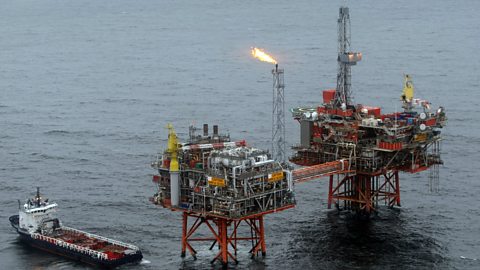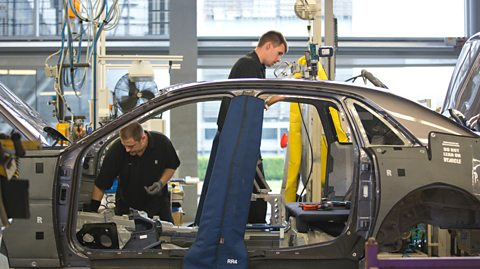What does this article about types of production cover?
Primary: Extracts raw materials (eg farming, mining)
Secondary: Manufactures products (eg car production)
Tertiary: Provides services (eg banking, hairdressing)
UK economic shifts: Moved from agriculture to manufacturing during the Industrial Revolution, then to services in the 20th century.
What are the types of production?
The sectors of industry and the economy explained
NARRATOR: Sectors of industry relate to what businesses do.
Primary sector businesses exploit or extract raw materials, like trees, fish, and oil.
Businesses in the secondary sector manufacture goods, often using the output from the primary sector. The construction industry is also in the secondary sector.
Tertiary sector businesses provide services, like shops, hospitals, and hotels.
Businesses also operate in three sectors of the economy. Sectors of the economy relate to how businesses are owned and how they are financed.
Private sector businesses, like sole traders, partnerships, and private limited companies, are owned by private individuals. Their aim is to make a profit.
Businesses in the public sector don't aim to make a profit. They're funded by the government and provide essential services like health and education.
Third sector businesses, like charities and social enterprises, are not for profit. They raise awareness of a cause or raise funds for their members.
Sectors of industry relate to what businesses do, and sectors of the economy relate to how they are owned and how they are financed.
The three main types of production (sometimes called the sectors of industry) in which a company can operate are:
primary
secondary
tertiary
What is primary production?
The primary sector of industry is concerned with the extraction of raw materials or natural resources from the land. Any business that grows goods or extracts materials from the land would be classed as a primary sector business.
Examples of businesses that operate in the primary sector would be farming, mining, fishing or oil production.

What is secondary production?
The secondary sector of industry is concerned with manufacturing. This involves taking raw materials from the primary sector and converting them into new products.
Examples of businesses that operate in the secondary sector are car manufacturers, food production or building companies.

What is tertiary production?
The tertiary sector of industry is concerned with providing a service. Services are activities that are done by people or businesses for consumers.
Examples of businesses that operate in the tertiary sector are hairdressers, banks, supermarkets or cinemas.

The UK economy: a changing picture
The UK economy has undergone a significant transformation over centuries. Initially, the backbone of the British economy was primary production. This meant that most people were involved in activities like farming, fishing, and mining. This period dominated until around the mid-18th century.
The Industrial Revolution, roughly from the late 1700s to the mid-1800s, marked a dramatic shift. The UK transformed into a manufacturing powerhouse, with factories springing up across the country. This era is known as secondary production. Industries like textiles, iron, and steel became the driving force of the economy. Millions of people left farms to work in bustling cities, drawn by the promise of new jobs.

However, the landscape changed once more in the latter half of the 20th century. The UK gradually moved towards a tertiary sector economy, where services became the dominant force. This meant a shift from making things to providing services like banking, education, and healthcare. This transformation was fuelled by technological advancements, globalisation, and changing consumer demands.

What factors contribute to economic shifts
Industrial Revolution:
The invention of machinery during this period significantly increased manufacturing efficiency. This meant factories could produce more goods with fewer workers, reducing the need for manual labour in agriculture. People were drawn away from farms to cities in search of factory jobs.
Globalisation and resource discovery:
The discovery of new resources and the expansion of global trade provided opportunities and incentives for industrial growth. Businesses could access a wider range of materials and reach new markets for their manufactured goods. For example, the discovery of vast coal reserves in Britain fuelled the Industrial Revolution.
Technological advancements:
Recent advancements in technology, like computers and automation, have further transformed the job market. These technologies have streamlined manufacturing processes, leading to a decline in manufacturing jobs. Conversely, they have created new opportunities in the service sector, requiring different skill sets. For instance, the rise of computers has led to a surge in demand for service-sector jobs like web design and software development.

Try the types of production quiz
Final checks
What was the dominant sector of the UK economy before the Industrial Revolution, and what activities were people primarily engaged in?
The primary sector was dominant before the Industrial Revolution, with most people involved in farming, fishing, and mining.